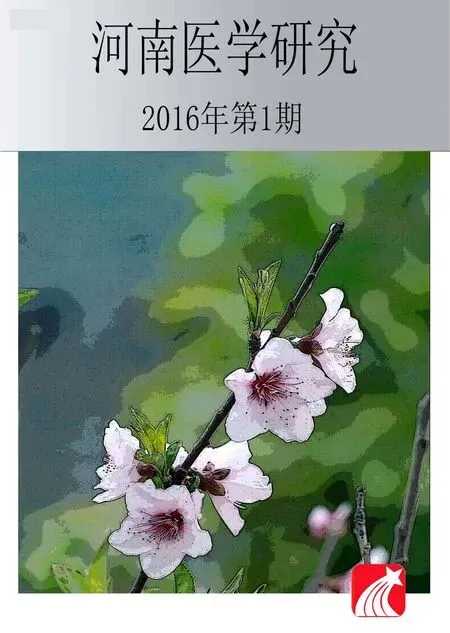呼吸支持模式對(duì)早產(chǎn)兒視網(wǎng)膜病的影響
孫慧清 康文清 李明超 許邦禮 郭靜 劉大鵬 熊虹(鄭州市兒童醫(yī)院新生兒重癥監(jiān)護(hù)室 河南鄭州 450053)
?
呼吸支持模式對(duì)早產(chǎn)兒視網(wǎng)膜病的影響
孫慧清 康文清 李明超 許邦禮 郭靜 劉大鵬 熊虹
(鄭州市兒童醫(yī)院新生兒重癥監(jiān)護(hù)室 河南鄭州 450053)
【摘要】目的 探討不同呼吸支持模式對(duì)早產(chǎn)兒視網(wǎng)膜病及血清VEGF和IGF-1水平變化的影響?方法 共578例出生胎齡小于34周,從第1次眼底篩查到最后1次眼底篩查生存的早產(chǎn)兒,所有納入研究早產(chǎn)兒被分為無(wú)ROP?1期?2期?3期以上ROP或3期ROP+plus病變?血清IGF-1?VEGF在生后1周?2周?3周和4周被檢測(cè)?結(jié)果 323例早產(chǎn)兒無(wú)ROP,126例早產(chǎn)兒發(fā)生1期ROP,80例發(fā)生2期ROP,39例發(fā)生3期以上ROP,10例患兒發(fā)生3期ROP+plus病變?對(duì)于1期ROP,機(jī)械通氣組的發(fā)生率是41%,顯著高于其他組(P<0.05);對(duì)于2期ROP,鼻導(dǎo)管吸氧組?CPAP組?機(jī)械通氣組與對(duì)照組的發(fā)生率類似,但是鼻導(dǎo)管吸氧組+CPAP組+機(jī)械通氣組ROP的發(fā)生率顯著高于對(duì)照組(P<0.05)?生后1周?2周?3周和4周血清IGF-1?VEGF水平各組間類似?結(jié)論 呼吸支持不同模式對(duì)早產(chǎn)兒2期以上ROP無(wú)明顯影響,對(duì)血清IGF-1和VEGF也無(wú)明顯影響?
【關(guān)鍵詞】呼吸支持;早產(chǎn)兒;視網(wǎng)膜病
早產(chǎn)兒視網(wǎng)膜病(ROP)是一多因素引起的嚴(yán)重視網(wǎng)膜血管增生性疾病,威脅到早產(chǎn)出生兒童的視力?醫(yī)療水平的提高使早產(chǎn)兒生存率增加,ROP發(fā)生的風(fēng)險(xiǎn)也相應(yīng)增加[1]?胎齡(GA)≤28周和機(jī)械通氣是嚴(yán)重ROP的獨(dú)立危險(xiǎn)因素[2]?機(jī)械通氣引起的氧合波動(dòng)被認(rèn)為與ROP顯著相關(guān)[2]?ROP的發(fā)病機(jī)理包括兩個(gè)階段,第一階段高氧導(dǎo)致血管生長(zhǎng)中斷,第二階段血管生長(zhǎng)受損的視網(wǎng)膜發(fā)育代謝需求增加,相對(duì)低氧環(huán)境下刺激血管內(nèi)皮生長(zhǎng)因子(VEGF)過(guò)度表達(dá),促進(jìn)異常血管新生延伸到玻璃體[3]?
早產(chǎn)兒的生存率增加,ROP是引起失明的主要因素?出生后因素包括低出生體質(zhì)量?低出生胎齡?男性?過(guò)度氧療和延長(zhǎng)的機(jī)械通氣被認(rèn)為與ROP的發(fā)生相關(guān)[4],而且,VEGF水平和胰島素生長(zhǎng)因子(IGF-1)在ROP的發(fā)生中起主要角色?然而,呼吸支持不同模式例如鼻導(dǎo)管吸氧?CPAP和機(jī)械通氣對(duì)ROP的影響未見報(bào)道,不同的呼吸支持模式對(duì)血清VEGF 和IGF-1是否有影響尚不清楚,本研究旨在探討不同的呼吸支持模式對(duì)ROP及血清VEGF和IGF-1水平的影響?
1 資料與方法
1.1 一般資料 本研究采用前瞻性隊(duì)列研究,按照我國(guó)衛(wèi)生部2004年制定的《早產(chǎn)兒治療用氧和視網(wǎng)病變防治指南》,對(duì)2009年1月至2014年12月出生符合條件的早產(chǎn)兒進(jìn)行視網(wǎng)膜病篩查?篩查對(duì)象為胎齡<34周或出生體質(zhì)量(BW)<2000 g的早產(chǎn)兒;BW>2 000 g但病情危重曾經(jīng)接受機(jī)械通氣或CPAP輔助通氣,吸氧時(shí)間較長(zhǎng)的新生兒?首次篩查時(shí)間為生后4~6周或糾正胎齡32周[5]?排除遺傳代謝病?先天畸形?不能堅(jiān)持到ROP最后1次檢查者[6],最后1次篩查時(shí)間為糾正胎齡42周?收集資料包括出生胎齡?出生體質(zhì)量?性別?血?dú)夥治?機(jī)械通氣時(shí)間?吸氧時(shí)間?ROP檢查結(jié)果?低血糖?高膽紅素血癥?支氣管肺發(fā)育不良?顱內(nèi)出血?壞死性小腸結(jié)腸炎和敗血癥?
1.2 呼吸支持模式 根據(jù)病情或血?dú)夥治?早產(chǎn)兒被給予鼻導(dǎo)管吸氧?鼻塞持續(xù)正壓通氣(Infant Flow,CareFusion,San Diego,California),常頻機(jī)械通氣(Ser-vo-i,Maquet,Wayne,New Jersey),或高頻振蕩通氣(SLE5000,SLE,South Croydon,United Kingdom)?機(jī)械通氣策略目標(biāo)是最佳的肺復(fù)張和避免肺不張,最佳的肺通氣是肺容積在8~9.5肋間,對(duì)有氣漏的嬰兒肺通氣在7~8肋間(肺氣腫或未放置引流管氣胸),氧合(SpO2of 92%~95%)被用來(lái)作為理想肺容積的直接指標(biāo)[7]?
1.3 ROP篩查和分類 所有早產(chǎn)兒根據(jù)《早產(chǎn)兒治療用氧和視網(wǎng)病變防治指南》進(jìn)行ROP篩查,ROP篩查由高年資眼科醫(yī)師進(jìn)行篩查,眼底檢查由間接眼底鏡和Retcam 3(廣域數(shù)字化照相儀)組成?根據(jù)ROP國(guó)際分類[8],ROP被分為1期(分界線)?2期(嵴形隆起)?3期(嵴形隆起伴纖維增殖)?4期(部分視網(wǎng)膜脫離)?5期(全部視網(wǎng)膜脫離)?
1.4 IGF-1?VEGF檢測(cè) 對(duì)入選早產(chǎn)兒在生后2周?3周和4周無(wú)菌采取外周血1.0 ml,經(jīng)離心后,-20℃保存待檢?IGF-1?VEGF測(cè)定采用雙抗體夾心ABC.ELISA法?
1.5 統(tǒng)計(jì)分析 采用SPSS 17.0統(tǒng)計(jì)學(xué)軟件進(jìn)行統(tǒng)計(jì)分析,定性資料采用χ2檢驗(yàn),定量資料采用兩獨(dú)立樣本數(shù)據(jù)t檢驗(yàn)及多樣本數(shù)據(jù)方差分析?以α=0.05為檢驗(yàn)水準(zhǔn)?
2 結(jié)果
在本研究中,共有609例早產(chǎn)兒進(jìn)行了ROP篩查,31例被排除,其中30例因資料不完整,1例因肛門閉鎖行外科手術(shù),最終578例早產(chǎn)兒被研究分析,323例早產(chǎn)兒無(wú)ROP,126例早產(chǎn)兒患1期ROP,80例患2 期ROP,39例患3期以上ROP,10例早產(chǎn)兒患3期ROP+plus疾病?
2.1 不同呼吸支持模式下ROP發(fā)生率 機(jī)械通氣組41%的患兒發(fā)生1期ROP,與其他組相比,差異有統(tǒng)計(jì)學(xué)意義(P<0.05)(見表1)?對(duì)于2期ROP,鼻導(dǎo)管吸氧組?CPAP組和機(jī)械通氣組與對(duì)照組類似,差異無(wú)統(tǒng)計(jì)學(xué)意義,但是,把需要吸氧的鼻導(dǎo)管吸氧組?CPAP組和機(jī)械通氣組一起與對(duì)照組比較,鼻導(dǎo)管吸氧組?CPAP組和機(jī)械通氣組3組合在一起2期ROP的發(fā)生率顯著高于對(duì)照組(P<0.05)?

表1 不同呼吸支持模式患兒ROP的發(fā)生率[n(%)]
2.2 不同呼吸支持模式患兒血清VEGF?IGF-1的變化 鼻導(dǎo)管吸氧組?CPAP組?機(jī)械通氣組與對(duì)照組生后1周?2周?3周?4周血清VEGF和IGF-1水平的變化比較,差異無(wú)統(tǒng)計(jì)學(xué)意義(P>0.05),提示血清VEGF和IGF-1水平與不同呼吸支持模式無(wú)顯著相關(guān)性?見表2?3?
表2 不同呼吸支持模式治療患兒VEGF水平(±s,pg/ml)

表2 不同呼吸支持模式治療患兒VEGF水平(±s,pg/ml)
注:F1值與P1值是不同呼吸支持模式各組之間的比較;F2值與P2值是不同呼吸支持模式各組與對(duì)照組之間的比較?
周對(duì)照組(n=20)鼻導(dǎo)管吸氧組(n=23)CPAP組(n=25)CMV組(n=20)HFOV組(n=18) F1P1F2P21 483.1±167.7 392.0±172.3 382.2±157.5 378.1±169.4 385.0±164.5 0.03 0.99 1.46 0.22 2 415.2±131.6 331.3±155.8 311.0±173.5 327.2±161.7 335.3±158.3 0.10 0.96 1.41 0.24 3 389.0±183.8 290.2±137.6 279.0±150.3 261.1±148.9 270.4±145.1 0.16 0.93 2.32 0.06 4 341.3±162.7 249.5±133.0 220.0±124.6 223.1±119.7 217.3±130.5 0.30 0.83 0.21 0.93
表3 不同呼吸支持模式治療患兒IGF-1水平(±s,pg/ml)

表3 不同呼吸支持模式治療患兒IGF-1水平(±s,pg/ml)
注:F1值與P1值是不同呼吸支持模式各組之間的比較;F2值與P2值是不同呼吸支持模式各組與對(duì)照組之間的比較?
周對(duì)照組(n=20)鼻導(dǎo)管吸氧組(n=23)CPAP組(n=25)CMV組(n=20)HFOV組(n=18) F1P1F2P21 32.1±14.2 34.5±15.9 35.3±16.7 36.0±17.3 35.7±15.9 0.03 0.99 0.19 0.94 2 30.3±13.9 30.7±14.3 31.2±13.8 32.5±14.7 32.1±14.1 0.07 0.98 0.09 0.99 3 33.4±13.2 33.9±13.8 34.5±14.3 35.3±16.5 35.8±15.8 0.06 0.98 0.27 0.90 4 34.1±14.9 34.7±13.1 35.2±16.1 36.7±15.9 36.0±14.7 0.07 0.97 0.09 0.98
3 討論
ROP是早產(chǎn)兒視網(wǎng)膜血管發(fā)育異常,潛在性地導(dǎo)致嬰兒失明,ROP與早產(chǎn)?低出生體質(zhì)量?高氧?感染等多種因素有關(guān)[6]?生后氧療被認(rèn)為是ROP的顯著高危因素[9]?足月兒視網(wǎng)膜和視網(wǎng)膜血管發(fā)育完全,因此不發(fā)生ROP,然而,早產(chǎn)兒視網(wǎng)膜發(fā)育不完善,視網(wǎng)膜發(fā)育成熟程度主要依靠于出生時(shí)胎齡[9]?機(jī)械通氣高壓氧輸送產(chǎn)生高氧環(huán)境,對(duì)萌發(fā)的視網(wǎng)膜血管直接有害[2]?本研究結(jié)果顯示,ROP的發(fā)生率與呼吸支持模式鼻導(dǎo)管吸氧?CPAP和機(jī)械通氣無(wú)明顯相關(guān)性,然而,ROP的發(fā)生率與有無(wú)呼吸支持治療顯著相關(guān)?
ROP的發(fā)生經(jīng)歷兩個(gè)階段,起始階段是血管受損,第二階段是血管增生,高氧和低氧調(diào)節(jié)生長(zhǎng)因子是ROP發(fā)生中的關(guān)鍵因素[10]?血管發(fā)生和血管生成是局部和全身生長(zhǎng)因子之間或刺激內(nèi)皮細(xì)胞有絲分裂?抑制分化?增生?遷移和成熟復(fù)雜相互作用的結(jié)果[11]?VEGF和IGF-1在發(fā)生ROP所起的作用不容忽視,VEGF被認(rèn)為是起源腫瘤的滲透增強(qiáng)因子,但后來(lái)顯示是內(nèi)皮細(xì)胞分裂[12]?動(dòng)物研究模型支持VEGF在眼睛神經(jīng)血管發(fā)育中的重要作用[13],ROP與多種因素有關(guān),發(fā)病機(jī)理由其他生化因子介導(dǎo)[14]?生長(zhǎng)激素和IGF-1被認(rèn)為通過(guò)控制VEGF活性在視網(wǎng)膜神經(jīng)新血管形成起一定作用[15]?本研究發(fā)現(xiàn)血清VEGF和IGF-1變化在不同呼吸支持模式間差異無(wú)統(tǒng)計(jì)學(xué)意義?
綜上,Ⅱ期或Ⅲ期ROP的發(fā)生率在不同呼吸支持模式下無(wú)顯著差異,血清VEGF和IGF-1水平與不同呼吸支持模式無(wú)顯著相關(guān)性?
參考文獻(xiàn)
[1] Rao K A,Purkayastha J,Hazarika M,et al.Analysis of prenatal and postnatal risk factors of retinopathy of prematurity in a tertiary care hospital in South India[J].Indian J Ophthalmol,2013,61(11):640-644.
[2] Kucukevcilioglu M,Mutlu FM,Sarici SU,et al.Frequency,risk fac-tors and outcomesof retinopathy of prematurity in a tertiary care hospi-tal in Turkey[J].Turk JPediatr,2013,55(5):467-474.
[3] Jasani B,Nanavati R,Kabra N.Mechanisms and management of reti- nopathy of prematurity[J].N Engl J Med,2013,368(12):1161-1162.
[4] Yu X D,Branch DW,Karumanchi S A,et al.Preeclampsia and reti-nopathy of prematurity in preterm births[J].Pediatrics,2012,130(1):e101-e107.
[5] Sun H,KangW,Cheng X,etal.The use of theWINROP screening al-gorithm for the prediction of retinopathy of prematurity in a Chinese population[J].Neonatology,2013,104(2):127-132.
[6] Wu C,Vanderveen D K,Helstrom A,et al.Longitudinal postnatal weight measurements for the prediction of retinopathy of prematurity[J].Arch Ophthalmol,2010,128(4):443-447.
[7] Sun H,Cheng R,KangW,et al.High-frequency oscilatory ventila-tion versus synchronized intermitentmandatory ventilation plus pres-sure support in preterm infants with severe respiratory distress syn-drome[J].Respir Care,2014,59(2):159-169.
[8] Fierson W M.Screening examination of premature infants for retinopa-thy of prematurity[J].Pediatrics,2013,131(1):189-195.
[9] Hauspurg A K,Alred E N,Vanderveen D K,et al.Blood gases and retinopathy of prematurity:the ELGAN Study[J].Neonatology,2011,99(2):104-111.
[10]Lauer A K.Intravitreal anti-VEGF in Retinopathy of Prematurity:Several years on[J].Asia Pac JOphthalmol(Phila),2014,3(6):329-330.
[11]Malik M A,Shukla S,Azad SV,etal.Vascular endothelial growth fac-tor(VEGF-634G/C)polymorphism and retinopathy of prematurity:a meta-analysis[J].Saudi JOphthalmol,2014,28(4):299-303.
[12]Jiang Y,Wang H,Culp D,et al.Targeting Muler cel-derived VEGF164 to reduce intravitreal neovascularization in the ratmodel of retinopathy of prematurity[J].Invest Ophthalmol Vis Sci 2014,55(2):824-831.
[13]Vinekar A,Gilbert C,Dogra M,et al.The KIDROP model of combi-ning strategies for providing retinopathy of prematurity screening in underserved areas in India using wide-field imaging,tele-medi-cine,non-physician graders and smart phone reporting[J].Indian J Ophthalmol,2014,62(1):41-49.
[14]Stahl A,Helstrom A,Smith L E.Insulin-like growth factor-1 and anti-vascular endothelial growth factor in retinopathy of prematurity:has the time come[J].Neonatology,2014,106(3):254-260.
[15]Kistner A,Sigurdsson J,Niklasson A,et al.Neonatal IGF-1/IGFBP-1 axis and retinopathy of prematurity are associated with increased blood pressure in preterm children[J].Acta Paediatr,2014,103(2):149-156.
Effects of respiratory supportmode on retinopathy of premature infants
Sun Huiqing,Kang Wenqing,Li Mingchao,Xu Bangli,Guo Jing,Liu Dapeng,Xiong Hong
(Department of Neonatology,Zhengzhou Children's Hospital,Zhengzhou 450053,China)
【Abstract】Objective To explore the efects of diferentmodes of respiratory supporton the occurrence of retinopathy(ROP)and the levels of VEGF and IGF-1 in premature infants.M ethods A total of578 premature infantswith gestational age(GA)of 34 weeks or lesswho had survived from the time of the initialophthalmologic examination to the final ROPexamination were in-cluded in the study.Each infantwas categorized as no ROP,stage 1,stage 2,more than stage 3 ROP or stage 3 ROP+plus disease.The serum levels of VEGF and IGF-1 were detected at postnatal 1,2,3,4 weeks.Results There were 323 infants without ROP,126 infants with stage 1 ROP,80 infants with stage 2 ROP,39 infants with≥stage 3 ROP and 10 infants with stage 3 ROP+plus disease.For stage 1 ROP,the incidence was 41%in mechanical ventilation group which was significantly higher than other groups(P<0.05).For the stage 2 ROP,the incidence of ROP was similar in control group,nasal cannula group,CPAP group,and mechanical ventilation group.But the incidence of ROP in nasal cannula,CPAP and mechanical venti-lation groups together was significantly higher than the control group(P<0.05).The levels of VEGF and IGF-1 at the end of 1 week,2 weeks,3 weeks and 4 weeks were similar between nasal cannula group,CPAP group,and mechanical ventilation groups.Infants receiving respiratory support and controls also had similar VEGF and IGF-1 levels.Conclusion Diferent modes of respiratory support do not afect the occurrence ofmore than stage 2 ROP,and also for the levels of VEGF and IGF-1 in premature infants.
【Key words】respiratory support;premature infants;retinopathy
(收稿日期:2015-08-10)
【中圖分類號(hào)】R 774.1
doi:10.3969/j.issn.1004-437X.2016.01.010

